On the 4th of July, an area west of San Antonio, Texas, suffered a series of flash floods in the pre-dawn hours.
Most of the devastation occurred in Kerr County in the Texas Hill Country, a popular area for hikers, campers, and summer camps. The counties of Travis, Burnet, Kendall, Tom Green, and Williamson were also affected.
The flash floods caused at least 82 deaths, including 28 children, with dozens of people still missing as of Monday morning. Camp Mystic, a girls' summer camp on the bank of the Guadalupe River, reported 27 of their campers and counselors among the dead or missing.
Some areas in the region received over 20 inches of rain, causing the Guadalupe River to rise over 26 feet (8 meters) in just 45 minutes, washing away everything in its path. The river hit 29.5 feet before the gauge was lost to the flood.
Other waterways and hillsides also experienced raging flood waters.
In the wake of the tragedy, Texas Republican Governor Greg Abbott, Department of Homeland Security head Kristi Noem, and representatives of Texas emergency services held a press conference on Friday.
They were swift to assign blame for the tragedy on the National Weather Service (NWS). While acknowledging that they received forecasts from the NWS, Texas Department of Emergency Management Chief Nim Kidd claimed the NWS drastically underestimated the amount of rain that would fall.
He told reporters:
"The amount of rain that fell at this specific location was never in any of those forecasts."
"The original forecast that we received Wednesday from the National Weather Service predicted 3-6 inches of rain in the Concho Valley and 4-8 inches in the Hill Country."
Kerrville City Manager Dalton Rice concurred, saying the affected communities were underprepared.
The administration of MAGA Republican President Donald Trump and unexplained cuts by his self-created Department of Government Efficiency (DOGE) caused 20% vacancy rates in half of the NWS forecast offices across the country by April, through early retirement buyouts and layoffs of all probationary and temporary personnel.
The NWS is in the process of hiring 100 new employees to maintain at least the most critical weather services.
But they're pushing back against the Texas emergency management narrative.
NWS meteorologist Jason Runyen said the New Braunfels office—which covers Austin, San Antonio and surrounding areas—had extra staff on duty during the storms due to the expectation of flooding. The NWS is doing a lot more with a lot less—an unsustainable long-term model—until critical positions can be filled, but that doesn't mean they aren't doing their jobs.
Runyen told NBC DFW News 5:
"There were extra people in here that night, and that's typical in every weather service office—you staff up for an event and bring people in on overtime and hold people over."
And they have a verified timeline of watches and warnings sent to state officials beginning on Thursday afternoon.
An NWS statement contended:
"Flash Flood Warnings were issued on the night of July 3 and in the early morning of July 4, giving preliminary lead times of more than three hours."
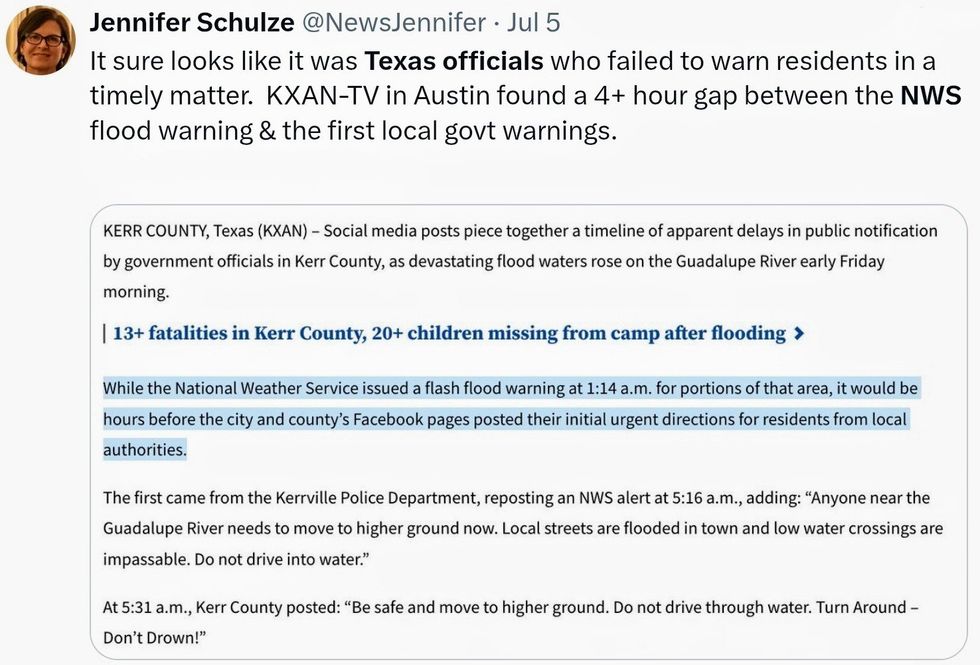
Here's the timeline provided by the NWS:
- The National Water Center Flood Hazard Outlook issued on Thursday July 3rd morning indicated an expansion of flash flood potential to include Kerrville, TX, and surrounding areas.
- A Flood Watch was issued by NWS Austin/San Antonio at 1:18PM CT on Thursday, in effect through Friday morning.
- The Weather Prediction Center (WPC) issued three Mesoscale Precipitation Discussions for the excessive rainfall event as early as 6:10PM CDT Thursday indicating the potential for Flash Flooding.
- The National Water Center Area Hydrologic Discussion at 6:22 PM CDT on 7/3/2025 messaged locally considerable flood wording for areas north and west of San Antonio, including the city of Kerrville.
- The first Flash Flood Warning for the event was issued at 11:41 PM CDT Thursday for Bandera County.
- At 1:14 AM CDT Friday: Flash Flood Warning with a considerable tag was issued for Bandera and Kerr Counties. Flash Flood Warnings with the Impact-Based Warning tags “Considerable” or “Catastrophic” denote high-damage threats and will automatically trigger Wireless Emergency Alerts (WEAs) on enabled mobile devices, ensuring only the most life-threatening flash flood events prompt urgent public notifications. All alerts are also sent out over NOAA Weather Radio.
- First reports from Kerr County Sheriffs Office of flooding at low water crossings had 201 minutes of lead time (4:35 AM CDT).
- Flash Flood Warning was upgraded to a Flash Flood Emergency for South-central Kerr County, Including Hunt, as early as 4:03 AM Friday.
- The 5:00 AM CT July 4th National Water Center Area Hydrologic Discussion included concern for widespread considerable flooding through the day. The Flood Hazard Outlook was also upgraded to considerable and catastrophic.
- Flash Flood Emergency issued for the Guadalupe River at 5:34 AM CDT.
Meteorologists independent of the NWS supported the agency, refuting the Texas officials' claims.
AccuWeather Chief Meteorologist Jonathan Porter wrote in a statement:
"The heartbreaking catastrophe that occurred in Central Texas is a tragedy of the worst sort because it appears evacuations and other proactive measures could have been undertaken to reduce the risk of fatalities had the organizers of impacted camps and local officials heeded the warnings of the government and private weather sources, including AccuWeather."
Chris Vagasky, a meteorologist based in Wisconsin, told NBC News:
"The forecasting was good. The warnings were good. It’s always about getting people to receive the message. It appears that is one of the biggest contributors—that last mile."
Houston meteorologist Matt Lanza—who noted the area is called Flash Flood Alley—wrote:
"By Tuesday afternoon [NWS] had specifically mentioned the potential for flooding... So the signals were there and got worse as Thursday progressed. Messaging and flood watches responded to this appropriately and expanded into Thursday evening."
"Issuing the warning is half the process. Were the warnings received and acted on? That's another story. And that will also come out in the days ahead. I think we need to focus our attention on how people in these types of locations receive warnings. This seems to be where the breakdown occurred."
"Flooding risk is high in Texas. People learn to live with it in some ways. But something like this absolutely cannot happen again."
Lanza concluded:
"This wasn’t a forecasting failure. It was a breakdown in communication."
On the Texas subReddit, a user noted:
"...local and state-level infrastructure failed too. Kerr County had no flash flood warning system."
According to the Texas Tribune, the Republican-controlled state legislature, under the leadership of GOP Governor Abbott, voted against a bill to improve local disaster warning systems.
Kerr County Republican state Representative Wes Virdell said he would probably vote differently now on House Bill 13—a grant program for counties to build new emergency communication infrastructure. Virdell has been out with first responders in his district as they search for victims of the floods.

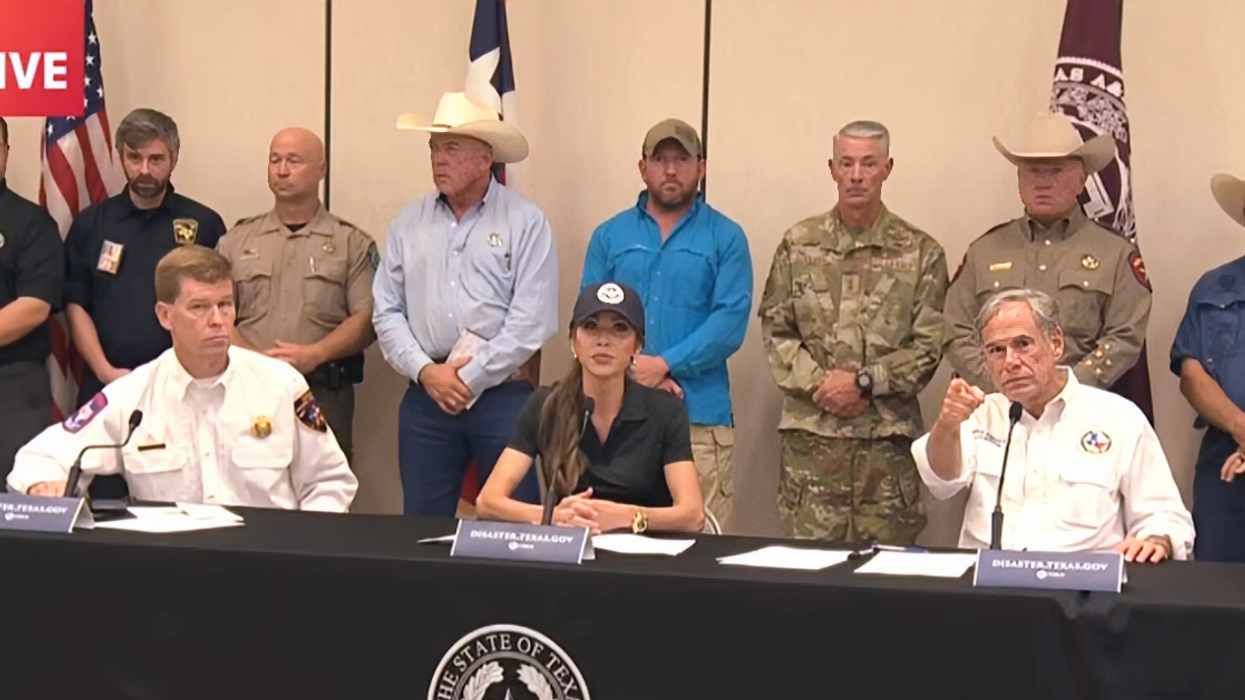






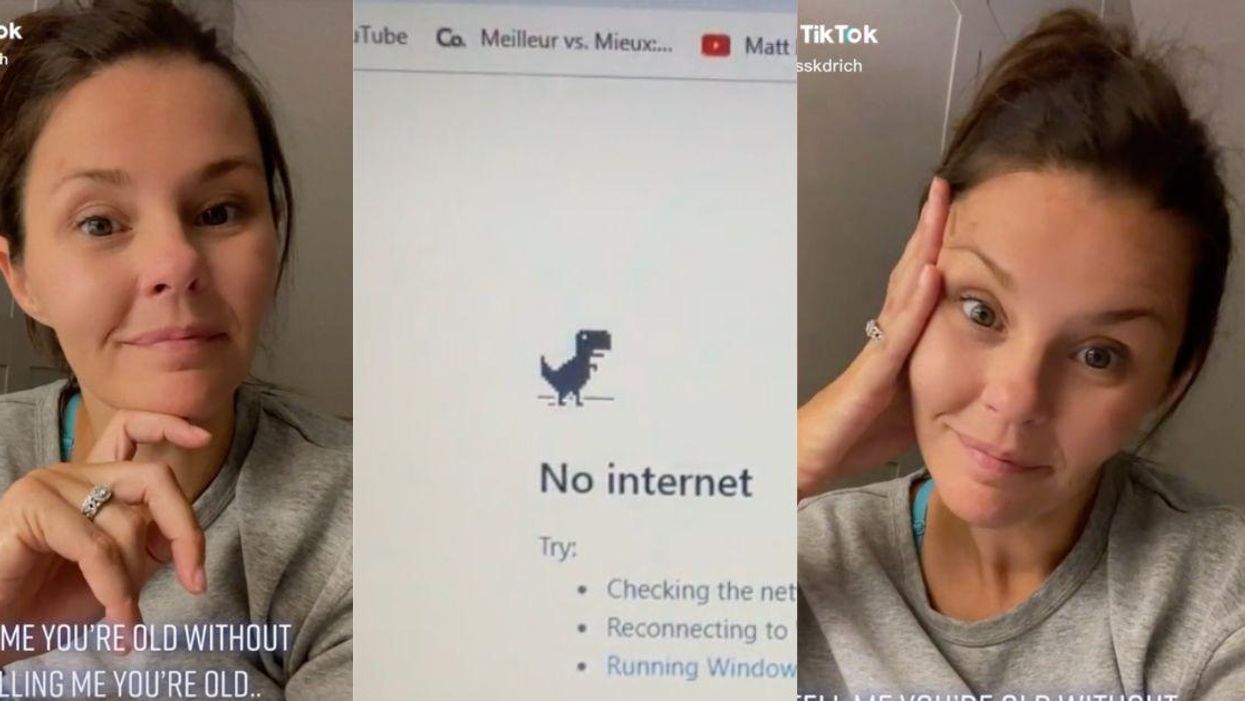

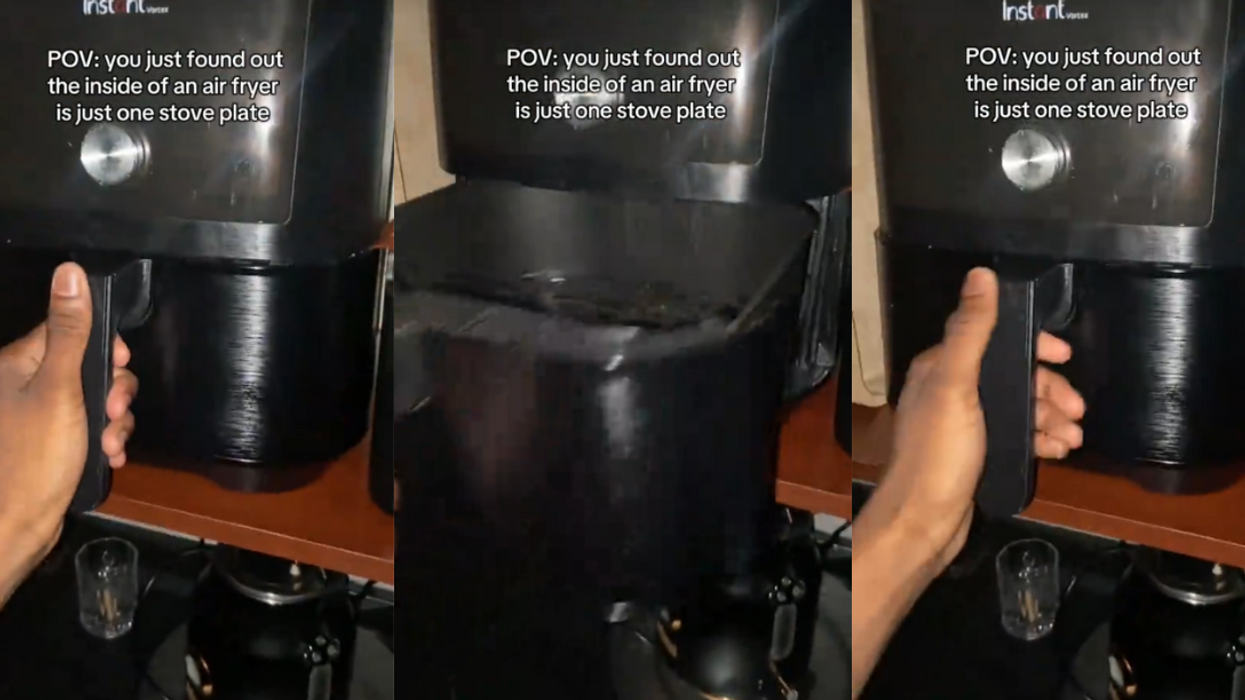



 @realDonaldTrump/Truth Social
@realDonaldTrump/Truth Social @realDonaldTrump/Truth Social
@realDonaldTrump/Truth Social

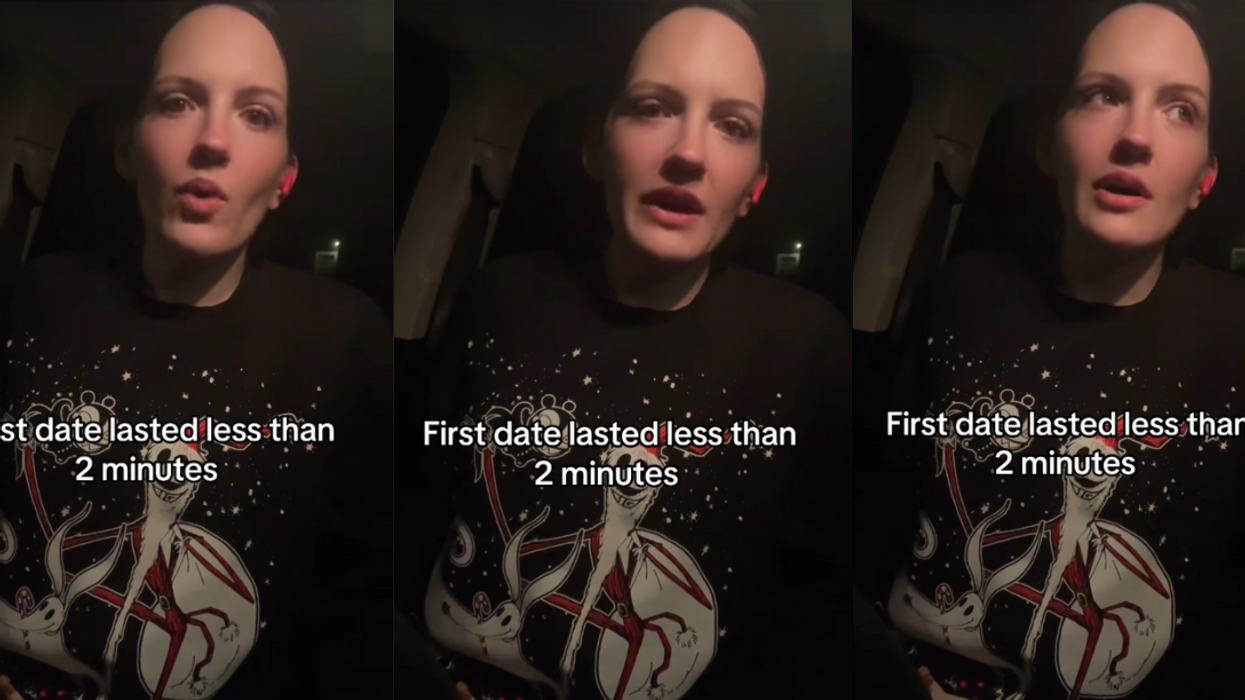
 @rachelanderson471/TikTok
@rachelanderson471/TikTok @rachelanderson471/TikTok
@rachelanderson471/TikTok @rachelanderson471/TikTok
@rachelanderson471/TikTok @rachelanderson471/TikTok
@rachelanderson471/TikTok @rachelanderson471/TikTok
@rachelanderson471/TikTok @rachelanderson471/TikTok
@rachelanderson471/TikTok @rachelanderson471/TikTok
@rachelanderson471/TikTok @rachelanderson471/TikTok
@rachelanderson471/TikTok @rachelanderson471/TikTok
@rachelanderson471/TikTok @rachelanderson471/TikTok
@rachelanderson471/TikTok @rachelanderson471/TikTok
@rachelanderson471/TikTok @rachelanderson471/TikTok
@rachelanderson471/TikTok @rachelanderson471/TikTok
@rachelanderson471/TikTok @rachelanderson471/TikTok
@rachelanderson471/TikTok @rachelanderson471/TikTok
@rachelanderson471/TikTok